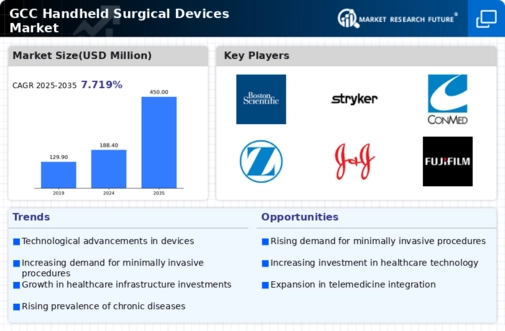Increasing Healthcare Expenditure
The handheld surgical devices market is significantly influenced by the rising healthcare expenditure in the GCC region. Governments and private sectors are investing heavily in healthcare infrastructure, leading to improved access to advanced surgical technologies. With healthcare spending projected to reach $100 billion by 2026, the demand for innovative handheld surgical devices is expected to surge. This financial commitment enables hospitals to acquire state-of-the-art surgical tools, thereby enhancing surgical outcomes and patient care. As healthcare budgets expand, the market for handheld surgical devices is likely to witness robust growth, reflecting the region's commitment to advancing medical technology.
Growing Awareness of Surgical Safety
Awareness regarding surgical safety and patient outcomes is increasingly impacting the handheld surgical devices market. Surgeons and healthcare professionals are prioritizing the use of devices that enhance safety and reduce the risk of complications during procedures. In the GCC, initiatives aimed at improving surgical standards and patient safety are gaining traction, leading to a heightened demand for reliable handheld surgical tools. This focus on safety is likely to drive market growth, as healthcare providers seek to adopt devices that align with best practices and regulatory standards. The emphasis on surgical safety is expected to shape purchasing decisions and influence market dynamics.
Expansion of Surgical Training Programs
The expansion of surgical training programs in the GCC region is contributing to the growth of the handheld surgical devices market. As medical education evolves, there is a greater emphasis on equipping surgeons with the skills necessary to utilize advanced handheld devices effectively. Training programs that incorporate the latest surgical technologies are becoming more prevalent, fostering a skilled workforce adept at using these tools. This trend is likely to enhance the adoption of handheld surgical devices, as trained professionals are more inclined to implement innovative solutions in their practices. The ongoing development of surgical education is expected to positively impact market dynamics.
Technological Innovations in Surgical Tools
Technological advancements play a crucial role in shaping the handheld surgical devices market. Innovations such as enhanced imaging systems, robotic-assisted tools, and smart surgical instruments are transforming traditional surgical practices. In the GCC, the integration of cutting-edge technologies is expected to drive market growth, with a projected increase of 12% in the adoption of these devices over the next five years. Surgeons are increasingly relying on these advanced tools to improve precision and outcomes during procedures. The continuous evolution of technology not only enhances the capabilities of handheld devices but also addresses the growing demand for safer and more effective surgical solutions.
Rising Demand for Minimally Invasive Procedures
The handheld surgical devices market is experiencing a notable increase in demand for minimally invasive surgical procedures. This trend is driven by the growing preference among patients for surgeries that result in less pain, reduced recovery time, and minimal scarring. In the GCC region, healthcare providers are increasingly adopting handheld surgical devices that facilitate these procedures, leading to a projected market growth of approximately 15% annually. The shift towards outpatient surgeries further propels the need for efficient and portable surgical tools, enhancing the overall patient experience. As hospitals and surgical centers invest in advanced handheld devices, the market is likely to expand, reflecting the evolving landscape of surgical practices.

















Leave a Comment